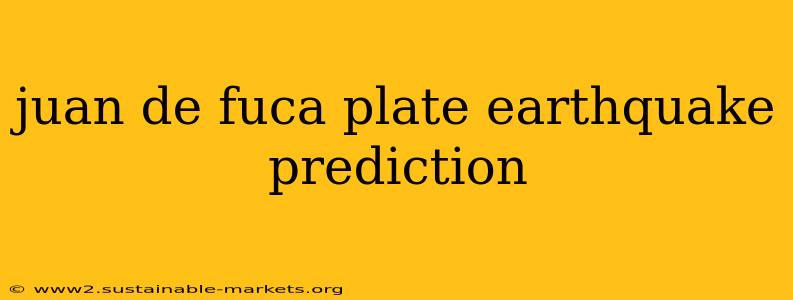The Juan de Fuca plate, a small oceanic tectonic plate situated off the coast of the Pacific Northwest, is a significant source of seismic activity. Its interaction with the North American plate creates a subduction zone, a region where one plate slides beneath another, resulting in frequent earthquakes and the potential for devastating megathrust events. Predicting these earthquakes, however, remains a monumental challenge. This article delves into the complexities of Juan de Fuca plate earthquake prediction, exploring current scientific understanding, limitations, and future prospects.
Understanding the Juan de Fuca Plate and its Seismic Activity
The Juan de Fuca plate is constantly moving eastward, subducting beneath the North American plate. This process is not smooth; it involves the build-up of stress along the fault lines, eventually leading to sudden releases of energy in the form of earthquakes. The Cascadia Subduction Zone (CSZ), located along the boundary between these two plates, is capable of producing massive megathrust earthquakes, similar to the one that devastated Japan in 2011. These events can have devastating consequences, including widespread ground shaking, tsunamis, and landslides.
Types of Earthquakes Associated with the Juan de Fuca Plate:
- Megathrust Earthquakes: These are the largest and most destructive earthquakes, occurring along the interface between the Juan de Fuca and North American plates. They can reach magnitudes exceeding 9.0.
- Intraslab Earthquakes: These occur within the subducting Juan de Fuca plate itself, at varying depths. While generally smaller than megathrust events, they can still cause significant damage.
- Crustal Earthquakes: These happen within the North American plate, closer to the surface. Though typically smaller in magnitude, they can still be felt strongly in populated areas.
The Challenges of Earthquake Prediction
Predicting earthquakes with precision—specifying the time, location, and magnitude—remains an elusive goal for seismologists worldwide. This is particularly true for the Juan de Fuca plate, where several factors contribute to the difficulty:
1. Complex Fault Geometry:
The CSZ is not a simple, uniform fault line. Its geometry is complex and irregular, making it challenging to model stress accumulation and release accurately.
2. Limited Historical Data:
While scientists have gathered considerable data on recent seismic activity, the historical record for megathrust earthquakes along the CSZ is relatively short. The last major event occurred in 1700, and understanding the long-term patterns of earthquake recurrence is crucial for prediction.
3. Incomplete Understanding of the Subduction Process:
The physical and chemical processes occurring deep within the subduction zone are not fully understood. This limits our ability to accurately model stress build-up and the triggering mechanisms of earthquakes.
Current Approaches and Future Directions
Despite the challenges, scientists are constantly refining their approaches to earthquake hazard assessment. These approaches focus less on precise prediction and more on probabilistic forecasting, providing estimates of the likelihood of earthquakes of different magnitudes occurring within a specific timeframe.
1. Seismic Monitoring Networks:
Dense networks of seismometers monitor ground motion constantly, providing valuable data on earthquake activity and stress accumulation.
2. Geodetic Measurements:
GPS and other geodetic techniques measure ground deformation, providing insights into the movement of tectonic plates and the build-up of strain energy.
3. Paleoseismology:
This field studies the geological record of past earthquakes, providing information about the frequency and magnitude of past events and helping to estimate recurrence intervals.
Future Research:
Future advancements in earthquake prediction will likely involve:
- Improved computational models: More sophisticated computer simulations of the subduction zone can help refine our understanding of stress accumulation and fault behavior.
- Advanced monitoring techniques: New technologies, such as fiber-optic sensors, may provide more detailed and real-time data on ground motion and strain.
- Interdisciplinary collaborations: Integrating geological, geophysical, and geochemical data can provide a more holistic picture of the processes involved in earthquake generation.
Conclusion
Predicting earthquakes on the Juan de Fuca plate with pinpoint accuracy remains beyond our current capabilities. However, ongoing research and advancements in monitoring and modeling techniques are continuously improving our understanding of earthquake hazards in the region. This improved understanding, while not offering precise predictions, enables better preparedness and mitigation strategies, helping communities to reduce the devastating impact of future seismic events. The focus is shifting from precise prediction to improved hazard assessment and risk reduction strategies.

